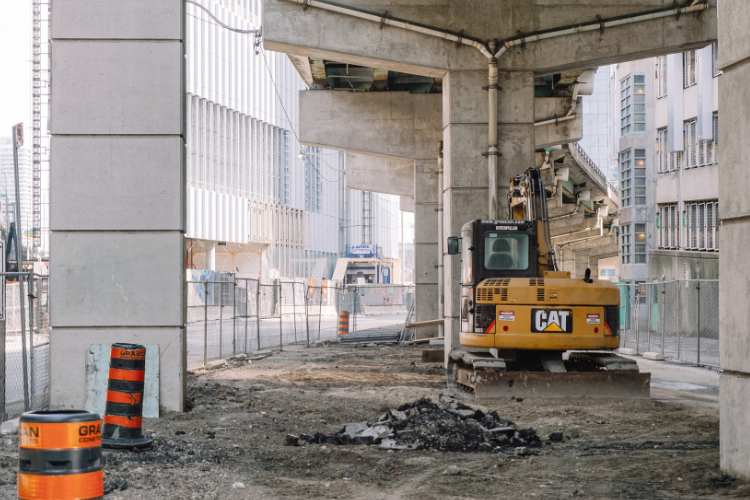In the construction industry, Subcontractors are the ones that make it happen. They coordinate with the GC and other trades, source and procure the right materials, install with skilled trades, and bring the project vision to life.
To make it happen, Subcontractors need access to working capital, which is often very difficult because supply chain finance has been terribly broken in the construction industry for decades.
We can do some simple math. For the average Subcontractor, it takes 56 days from the time they front a project-related expense until they are paid on that project. That means, for every $1M of annual revenue, you need $187k of working capital. Subcontractors use a combination of their own cash, bank lines of credit, supplier terms, material financing, and alternative forms of financing to bridge this gap. Because most Subcontractor businesses do not typically raise outside equity capital, their cash is limited to retained profits; all other forms of working capital rely on using a form of financing.
Herein lies the problem: When it comes to financing, these vital players are often overlooked, and the risks associated with lending to Subcontractors are misunderstood or, worse, unknown. The construction industry’s unique complexities can make Subcontractor lending a challenging endeavor, especially when the financial landscape is dominated by models that thrive on known and quantifiable risks, such as FICO scores in consumer lending. This gap in understanding and quantifying risk leads to inefficiencies in supply chain finance and increased costs to Subcontractors.
Table of Contents
The Basics of Risk and Lending
In finance, there’s a fundamental concept known as the “risk-free rate,” often represented by the yield on a U.S. Treasury note. This rate sets the benchmark for all other lending because it’s considered a safe investment with almost no risk. When a lender assesses the risk of any borrower, whether it’s an individual applying for a mortgage or a company seeking a business loan, the starting point is the risk-free rate. The higher the quantified risk, the more the lender will charge to compensate for that risk.
For example, in consumer lending, an individual with a high FICO score, say 800, might secure an auto loan at 6% interest because the quantified risk is well understood. Conversely, someone with a lower FICO score, say 550, might face an interest rate of 12% or higher. This difference in interest rates is directly related to the risk assessment, which is quantified and known through the U.S.’s well-known credit scoring system. The higher the quantified risk, the more the lender will charge.
The Unknown Risks in Construction Lending
When it comes to traditional quantified risk in the construction industry, Subcontractors are in trouble. They serve as owner-operator, managing low cash balances, unpredictable payment timing, thin business credit files, and very few unlevered assets. For these reasons, construction needs a vertical-specific risk assessment to quantify risks.
Unlike consumer lending where FICO scores provide a clear indicator of risk, construction lending lacks a universally accepted model to quantify the risks that are unique to Subcontractors. This absence of standardized risk assessment tools leads to what we call an “unknown risk.”
Unknown risk is different from known risk. As an example, in consumer lending, a low FICO score represents a known risk, which can be quantified and priced accordingly. However, an unknown risk needs to be priced even higher because the unknown factors cannot be measured. Capital and credit markets price unknown risk at the highest perceived level to protect against potential losses, which inevitably leads to a higher cost of financing.
In construction, the risks associated with Subcontractors are often not well understood by capital and credit markets. The lack of clarity results in unknown risk. Because lenders cannot accurately assess this risk, they tend to overprice it, resulting in higher interest rates and inefficient supply chain finance.
The Impact of Inefficient Supply Chain Finance
Inefficient supply chain finance in the construction industry has far-reaching consequences. When the risk is unknown and therefore overpriced, Subcontractors face higher borrowing costs. Subcontractors have recently started understanding the cost of their working capital and including in their bids (45% of subs are currently doing this according to the 2025 National Subcontractor Market Report), but have historically simply eaten this cost as if it was some kind of tax for not having a war chest of cash in the bank. The overall impact trickles down the supply chain, affecting general contractors and developers who may face higher costs and delays in construction projects.
This inefficiency also creates a vicious cycle. High borrowing costs can limit Subcontractors’ ability to take on new projects or invest in their businesses, which in turn stifles growth and innovation in the industry. It can also limit both the types of working capital and the work capital capacity for subcontractors, making it increasingly difficult to manage cash flow. The lack of a standardized risk assessment model exacerbates this issue, keeping the cost of capital artificially high and hindering the overall efficiency of the construction industry.
Quantifying the Unknown: A New Approach
At Billd, our mission is to bridge this gap by quantifying the unknown risk associated with Subcontractors in the construction industry. What Billd has proven is that actual Subcontractor risk management must include the projects they are on (GCs, project types, size of project, etc.), as well as the characteristics of the Subcontracting business. This is the benefit of supply chain financing: You can understand more aspects of the business than simple attributes like cash balances, debt ratios, etc. Our overall goal is to eliminate the concept of the unknown risk entirely so that lending is set to an exact, quantified risk factor.
Just as FICO scores have revolutionized consumer lending by providing a standardized measure of risk, we aim to develop a predictive risk model that accurately reflects the true risk of working capital finance to Subcontractors.
Our approach involves gathering and analyzing performance data from thousands of Subcontractors and projects. Since Billd was founded in 2018, we’ve funded nearly $750M across 30,000 financings and 5,000 projects. By examining factors such as the type of project, the experience of the general contractor, the property value, and other relevant variables, we can begin to build a comprehensive risk model. Over time, as we collect more data and refine our models, we can reduce the unknown risk and provide a more accurate and efficient pricing structure for lending.
When we obtain more and more performance data, we can connect the dots between capital and credit markets and the construction industry. This performance data allows us to more accurately quantify the risk factors involved and proves that our predictable risk model works effectively. Ultimately, this leads to reduced risk, supported by many cohorts of credit performance.
The Road to Efficient Supply Chain Finance
Our ultimate goal at Billd is to create a more efficient supply chain finance system in the construction industry. By turning unknown risk factors into better known risk factors, we can lower the cost of borrowing for Subcontractors without sacrificing the accuracy of risk assessment. This doesn’t mean that all Subcontractors will suddenly qualify for the lowest possible rates; risk will always exist. However, it does mean that the risk will be priced more accurately, reflecting not only the true nature of the Subcontractor’s financial health and project potential, but also their ability to position themselves as financially responsible, low-risk lending partners.
Consider a Subcontractor working on a $12 million parking garage project in Austin. With our model, we can assess not only the Subcontractor’s business creditworthiness, but also the project-level attributes that are the better indicator of payment to the Subcontractor.
This detailed analysis allows us to create a more precise risk profile for the Subcontractor, which can then be communicated to lenders. As a result, the Subcontractor might receive a more favorable loan rate, reflecting the actual risk rather than an inflated one due to uncertainty.
Translating Data into Action
One of the key challenges in this process is translating our risk models into a language that credit markets understand. Wall Street relies on proven risk models to make investment decisions, and our job is to present performance data in a way that resonates with these markets, leveraging our deep experience and a team of seasoned credit executives and capital market professionals. We have the right people to bridge the gap between our sophisticated algorithms and the insights Wall Street needs to accurately assess the risk of lending to Subcontractors.
As we continue to build and refine our models, we are proving to the capital markets that the risks associated with Subcontractor lending are lower than previously thought. Over time, this should lead to lower borrowing costs for Subcontractors, increased stability in the construction industry, and more efficient allocation of capital across the supply chain.
The Future of Construction Finance
The construction industry is on the brink of a transformation in how it approaches finance, particularly when it comes to lending to Subcontractors. By moving from a system of inefficient supply chain finance—driven by unknown and therefore overpriced risk—to one where risks are accurately quantified and priced, we can unlock significant value for all stakeholders.
We’re committed to leading this transformation here at Billd. By developing and refining predictive risk models, we aim to reduce the unknown risk in Subcontractor lending, making it possible for more Subcontractors to access the capital they need at the right price. This not only benefits Subcontractors but also strengthens the entire construction industry, leading to more projects completed on time and on budget, and ultimately, a more efficient and resilient industry as a whole.







